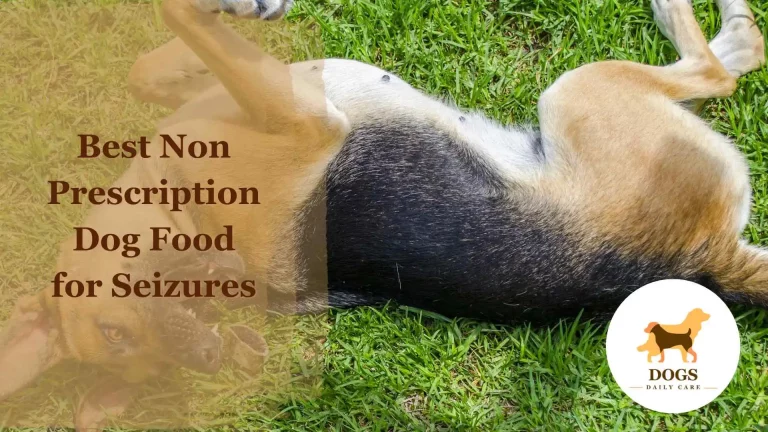How To Stop Dog Seizures Naturally? – An Ultimate Guide
Watching our furry companions go through a seizure can be a harrowing experience. Seizures, which result from sudden abnormal electrical activity in the brain, are not only distressing for dogs but also for the pet owners who witness them. While there are various traditional medications available to treat and manage seizures, many pet owners are turning towards natural remedies in search of a more holistic approach.
In our journey ahead, we’ll delve into the myriad of natural ways to manage dog seizures, from dietary tweaks to herbal supplements. But remember, before trying any new treatment, always consult with your veterinarian to ensure the best care for your beloved pet.
Understanding Dog Seizures

When we talk about seizures in dogs, we’re referring to a sudden burst of uncontrolled electrical activity in the brain. This erratic brain activity can manifest in a variety of physical symptoms, ranging from uncontrolled shaking and salivation to momentary loss of consciousness. Recognizing the types and causes of seizures is the first step in offering our dogs the right care and support.
There are multiple types of seizures dogs might experience. The most common are:
- Generalized Seizures: Often referred to as ‘grand mal’ seizures, these affect both sides of the brain and typically involve full-body convulsions.
- Focal Seizures: These start in one specific area of the brain and may affect only one limb or one side of the dog’s body. They can sometimes progress to generalized seizures.
- Cluster Seizures: This is a series of seizures in a short timeframe, and it’s crucial to seek veterinary attention immediately if this occurs.
- Status Epilepticus: Continuous seizures that don’t stop or seizures that occur in quick succession without the dog regaining consciousness between them. This is a medical emergency.
As for the causes, seizures can arise from various sources. Some dogs may have genetic predispositions or underlying health issues like liver or kidney disease. Exposure to toxins, head injuries, or infections like distemper can also trigger seizures. And then there are idiopathic seizures, where the cause remains unknown, often labeled as epilepsy in dogs.
Knowledge is power. The better we understand dog seizures, the better equipped we are to help our pets navigate through them and explore both traditional and natural avenues of treatment. Always remember, each dog is unique; what might trigger a seizure in one dog might not in another. It’s all about observing, understanding, and seeking the right care.
The Importance of Consulting a Veterinarian

Embarking on a natural wellness journey for our pets is commendable. The appeal of holistic treatments, the allure of fewer side effects, and the genuine desire to provide the best for our pets can drive many of us towards alternative remedies. But it’s paramount to remember one golden rule: always consult with a veterinarian before introducing any new treatment, be it natural or otherwise.
Veterinarians are not just medical experts; they’re also familiar with your dog’s unique medical history, breed-specific risks, and current health status. They can provide insights into whether a particular natural remedy might benefit your dog or if there are potential interactions with existing medications. Simply put, their guidance is invaluable in ensuring the safety and efficacy of any treatment approach.
It’s easy to get swayed by anecdotal success stories online or testimonials from fellow pet owners. While these can be informative and sometimes even inspiring, self-diagnosing and treating based on such information can be risky. Seizures can be symptoms of underlying issues that need to be properly diagnosed. Overlooking these or using remedies without professional guidance might not only be ineffective but potentially harmful.
In summary, while exploring natural ways to manage dog seizures is a proactive approach, doing so under the guidance of a veterinarian ensures that we’re making informed, safe decisions for our furry friends. Remember, our goal is their well-being, and professional advice is the cornerstone of achieving that.
Natural Remedies for Dog Seizures
The world of natural remedies offers a plethora of options for various ailments, and dog seizures are no exception. Pet owners are increasingly leaning towards holistic treatments, hoping to find a gentle yet effective solution. While some natural remedies have shown promise in managing seizures, it’s crucial to approach them with an informed mindset and always under the guidance of a veterinarian.
Diet and Nutrition

The foundation of any dog’s health lies in its diet. Some studies suggest that a ketogenic diet, high in fats and low in carbohydrates, can potentially reduce seizure frequency in dogs. Omega-3 fatty acids, found in fish oil, have also shown anti-inflammatory properties that might benefit brain health. Remember, a balanced diet tailored to your dog’s specific needs is essential. Also it’s necessary to know the best non-prescription dog food for seizures.
Herbal Supplements

Certain herbs, like chamomile, passionflower, and skullcap, have traditionally been used for their calming and anti-seizure properties. However, the correct dosage is crucial, and some herbs can interact with medications, so always consult with a vet before introducing any new supplement.
Acupuncture

An ancient practice that involves inserting thin needles at specific points on the body, acupuncture has gained popularity in veterinary medicine. Some pet owners report a reduction in seizure frequency and severity after consistent sessions. Always ensure you’re working with a certified veterinary acupuncturist.
Essential Oils

Lavender, frankincense, and chamomile are some of the essential oils believed to have calming effects. However, it’s crucial to use them correctly. Dogs have a more sensitive sense of smell, so always dilute oils, choose therapeutic-grade, and monitor your pet for any allergic reactions.
CBD Oil

Cannabidiol (CBD) oil, derived from the hemp plant, has garnered significant attention for its potential benefits in managing various ailments, including seizures. Preliminary studies have shown promise, but it’s essential to source high-quality, THC-free CBD oil and determine the right dosage for your dog.
In the realm of natural remedies, one size doesn’t fit all. What works wonders for one dog might not have the same effect on another. It’s a journey of exploration, observation, and fine-tuning, always with your dog’s best interests at heart and with the guidance of a trusted veterinarian.
Lifestyle Adjustments

Beyond supplements and treatments, the environment and daily routines of our dogs can play a pivotal role in their overall well-being and seizure management. Adjusting certain lifestyle aspects can create a conducive environment for dogs prone to seizures, minimizing triggers and promoting overall health.
Stress Reduction
Just like humans, dogs can be adversely affected by stress. Changes in the household, loud noises, or even a new pet can potentially trigger a seizure in sensitive dogs. Offering a calm environment, using anxiety wraps during thunderstorms or fireworks, and maintaining regular routines can help mitigate stress-related triggers.
Regular Exercise
Physical activity is not only beneficial for a dog’s physical health but also their neurological well-being. Regular walks, play sessions, and mental stimulation through puzzles or toys can keep a dog’s brain and body active and healthy. However, ensure that the exercise is consistent and not overly strenuous, as sudden bursts of intense activity might be counterproductive.
Environmental Toxins
Household chemicals, certain plants, and even some foods can be toxic to dogs and act as seizure triggers. Ensure that cleaning agents are pet-safe, plants are non-toxic, and foods like chocolate, grapes, and certain artificial sweeteners are out of reach. Consider using natural cleaners and being aware of what’s accessible to your pet.
Quality Sleep
A good night’s rest is essential for everyone, including our furry friends. Ensure your dog has a comfortable sleeping space, free from disturbances. If your dog appears to be restless or has disrupted sleep, consult with your vet as it could be a sign of discomfort or an underlying issue.
Stay Informed and Observant
The more you know about seizures and their potential triggers, the better equipped you’ll be to make the necessary lifestyle tweaks. Regularly monitor your dog, noting any changes in behavior, diet, or health. This proactive approach can provide invaluable insights into what works best for your individual dog.
In essence, lifestyle adjustments are about creating a nurturing, safe, and consistent environment for your dog. When combined with the right treatments and under the guidance of a veterinarian, these changes can significantly improve the quality of life for a dog prone to seizures.
Monitoring and Recording Seizure Activity
For dog owners faced with the challenge of managing seizures, understanding the patterns and potential triggers becomes indispensable. Establishing a systematic way to monitor and record seizure activity can empower you with insights, aiding in better management and more informed consultations with veterinarians.
1. Why Keep a Seizure Diary?
By consistently documenting each seizure episode, you’ll start to notice patterns. These patterns could point towards specific triggers, effective interventions, or even indicate when a change in treatment might be necessary. Over time, this record becomes an invaluable tool for both you and your veterinarian.
2. What to Document:
- Date and Time: Establishing a timeline can help determine any patterns, like specific times of the day or month when seizures are more frequent.
- Duration: How long did the seizure last? Note the start and end times.
- Type of Seizure: Was it a generalized seizure, focal, or another kind? Describing the symptoms can help categorize it.
- Potential Triggers: Were there any unusual events, noises, or changes in the environment before the seizure?
- Post-Seizure Behavior: Often, dogs might exhibit confusion, restlessness, or fatigue after a seizure. Documenting this can provide clues about the severity and recovery.
3. Tools and Aids:
In today’s digital age, various apps can assist in logging and analyzing seizure activity. However, a simple notebook or a dedicated diary can be just as effective. What’s essential is consistency in recording and regular reviews.
4. Sharing with Your Veterinarian:
During your veterinary visits, sharing this diary can offer a comprehensive view of your dog’s condition over time. Such detailed records can assist in tailoring treatments, adjusting dosages, or exploring alternative therapies.
In conclusion, while facing dog seizures can be daunting, taking an active role in monitoring and understanding the condition can make a world of difference. By being observant, diligent in record-keeping, and consistently collaborating with veterinary professionals, you’re taking essential steps to ensure the best care for your beloved pet.
Frequently Asked Questions (FAQs)
Managing and understanding dog seizures can be overwhelming. To assist you further, we’ve compiled a list of commonly asked questions to shed more light on this complex topic.
1. What are the first signs of a dog having a seizure?
Typical signs include sudden behavioral changes such as restlessness or looking dazed. This can escalate to uncontrollable shaking, drooling, stiffening of the body, or even collapsing. The dog might also paddle its legs or chew involuntarily. Each dog is unique, so symptoms can vary.
2. Can a dog recover fully after a seizure?
Yes, most dogs recover after a seizure episode, although the recovery period can vary. Some dogs bounce back immediately, while others might appear disoriented or tired for hours. It’s essential to provide a calm environment and observe them closely during this recovery phase.
3. Are there certain breeds more prone to seizures?
While seizures can occur in any dog breed, some are genetically predisposed. Breeds like the Beagle, Belgian Tervuren, Golden Retriever, Labrador Retriever, and Shetland Sheepdog, among others, have shown a higher incidence. However, any dog, irrespective of breed, can have seizures due to various reasons.
4. How can I comfort my dog during a seizure?
Stay calm. Ensure your dog is in a safe location, away from stairs or sharp objects. Speak in a soothing voice, but avoid touching the dog’s mouth or head, as they might unintentionally bite. Once the seizure subsides, keep the environment quiet and comfort your dog as they recover.
5. Should I visit the vet after every seizure?
If it’s your dog’s first seizure, contact your vet immediately. For subsequent seizures, a visit might not be necessary every time, but it’s essential to keep your veterinarian informed. If the seizure lasts more than 5 minutes, or if your dog has multiple seizures in a short span (cluster seizures), seek emergency veterinary care.
Conclusion
Navigating the complexities of dog seizures can be an emotional journey for any pet owner. However, armed with the right knowledge, natural remedies, and a proactive approach, it’s possible to manage and even mitigate the challenges that come with this condition. Remember, while natural treatments offer promise, they work best when combined with regular veterinary consultation and a tailored care plan for your furry friend.
Your dog’s health and well-being are paramount. Whether it’s dietary changes, lifestyle adjustments, or the introduction of herbal supplements, always prioritize safety and efficacy. By staying informed, observant, and forging a collaborative relationship with veterinary professionals, you can provide the best possible care for your beloved pet in their time of need.







